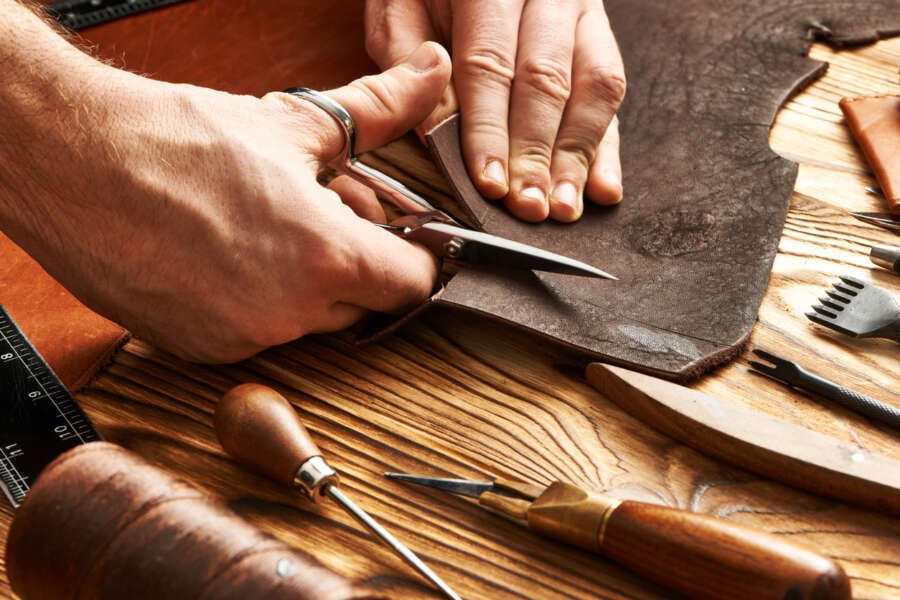
By Steve Sothmann of Real Leather. Stay Different

The ‘forever wardrobe’ is being touted as the next big trend. A move away from the wastefulness and transience of fast fashion, it is all about choosing classic, timeless pieces that will last. A crisp white shirt, blue jeans, a Breton top, ago-with-anything leather jacket. In fact, any leather item rightly deserves to be included. Not only is leather durable but also, if properly maintained, it improves with age.The challenge is navigating the various choices and ‘leather’ alternatives on the marketto ensure that your ‘forever’ leather purchase is as authentic and sustainable as it claims.
Check the label
Leather has a distinctive smell and feels warm to the touch. It also tends to have blemishes or imperfections. However, this is open to interpretation so your first step should be to check the label or tag. If it’s real leather, it will proudly say so.
Watch out for bonded leather (or reconstituted leather), whichis less desirable; it is the least expensive leather and sits at the bottom of the grading scale. It is made by grinding up scrap leather, mixing it with a binding agent, usually latex or polyurethane, and“bonding” it onto a fibre sheet that is then stamped with a leather grain pattern.
Instead, look for 100% real leather, full or top grain leather or genuine leather.
Also, if the label says that it is a man-made material, that means it is synthetic. Likewise, if it says nothing at all, the chances are that it isn’t the genuine article.
Avoid imitations
In your search for the perfect leather item, you will likely come across ‘leather’ imposters purporting to be more sustainable than the real thing. Sometimes called vegan leather, faux leather or leatherette, these materials aren’t leather at all. They are typically made from synthetic materials that are non-renewable and oil-based (in other words, plastics). The problem is that they aren’t as tough and when these materials are disposed of, they stick around for hundredsof years and can enter waterways, causing harm to marine life.
Even some of the natural alternatives that are gaining popularity, such as pineapple or mushroom ‘leather’, use synthetic products as binding agents and are creating whole new energy-intensive industries! So, while they might not be animal products, they are far from the pure, sustainable choice their vegan claims imply. And whether they match leather in terms of durability remains to be seen – they simply haven’t been around for long enough.
Buy sustainably, buy premium
Thecost of potential purchase is also telling. Real leather is usually much more expensive than imitations, so if the price seems too good to be true then it probably is.
Cost can also be a factor if, like a growing number of consumers, you care about the environmental impact of your purchases. If you are buying from a high-end, luxury producer, you can be fairly confident they will abide by best practice in their manufacturing process. Their profits are derived from great design and craftmanship and they won’t compromise that by using anything but the highest quality leather from producers who are certified to the highest environmental standards.
The best producers should be open about their supply chains. If you need further clarification, check the corporate responsibility and sustainability sections on their websites.
Look for proof of sustainable standards
For further reassurance on the sustainability of an item, look out for The Leather Working Group (LWG) and Sustainable Leather Foundation (SLF) logos. Both organisations provide environmental audits and traceability standards, and brands and retailers can use the logos on their website to indicate that they are using leather products that have been audited.Alternatively, ask your brand or retailer to support their environmental claims through traceable standards. If in doubt, you can check out consumer information for an LWG member here or for an SLF member here.
Keep an eye on innovation
In your quest for real, sustainable leather you might come across‘regenerative’ leather.It is not yet mainstream and the industry is still defining the characteristics of regenerative farming, but a select few brands now offer it.
Regenerative leather comes from cows that are reared using practices that have a restorative function on the soil and the environment.In buying regenerative leather, you are not only purchasing a by-product of the meat and dairy industrythat would otherwise go to waste, but you are also supporting production practices that improve the land.
Invest for the long term
When you have done your research andare ready to make your leather purchase, bear in mind that you are investing in an item that is the opposite of fast, throw-away fashion that will be a wardrobe staple for many years to come. So, choose wisely and with an eye to the future. That means opting for classicpieces that transcend fashion fads and trends,and that you can treasure forever.


